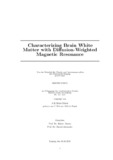Please use this identifier to cite or link to this item:
http://archive.nnl.gov.np:8080/handle/123456789/258| Title: | Characterizing brain white matter with diffusion-weighted magnetic resonance |
| Authors: | Dhital, Bibek |
| Keywords: | Diffusion Brain white matter Nuclear magnetic resonance |
| Issue Date: | 10-Dec-2017 |
| Abstract: | It has been known for almost two decades that the water proton NMR signal of di using water molecules in brain white matter undergoes a non-monoexponential decay with increasing di usion gradient factor b. With the help of numerical simulations and analytical expressions, much e ort has been directed to describing the signal decay and to extracting relevant biophysical features of the system under investigation. However, the physical basis of such nonmonoexponential behavior is still not properly understood. The primary di culty in characterizing this phenomenon is the variation in behavior in the di erent directions of di usion measurement. A combined framework that accounts for the di usion process in all directions requires several parameters. Addition of many such parameters renders a model to be unwieldy and over-complicated, but over-simpli cations can be shown to miss crucially relevant information in the data. In this thesis, I have attempted to handle this problem with simple measurements that span a wide range of parameter space. Compared to often-performed measurements that probe di usion over a time-scale of 50-100 ms with relatively low di usion weighting, the measurements here have been done for very short di usion times of 2 ms and also very long di usion times up to 2 s. The temperature dependence of the di usion coe cients has also been extensively probed. To avoid problems related to gross tissue heterogeneity, di usion-weighted MR imaging in vivo was performed with ultra-high resolution. These simple measurements allowed sequential assessment of many possible arguments that could have led to such non-monoexponential decay curves. Finally, it was concluded that the water in the glial processes was the major contributor to the non-exponential decay, giving rise to a 'slow' component both along the axonal bers and transverse to them. |
| Description: | Dissertation submitted for obtaining the academic degree on Doctor of Naturalium to the University of Leipzig, Faculty of Physics and Earth Sciences, 2015. |
| URI: | http://103.69.125.248:8080/xmlui/handle/123456789/258 |
| Appears in Collections: | 500 Natural sciences and mathematics |
Files in This Item:
| File | Description | Size | Format | |
|---|---|---|---|---|
| Thesis.pdf | 4.88 MB | Adobe PDF |  View/Open |
Items in DSpace are protected by copyright, with all rights reserved, unless otherwise indicated.